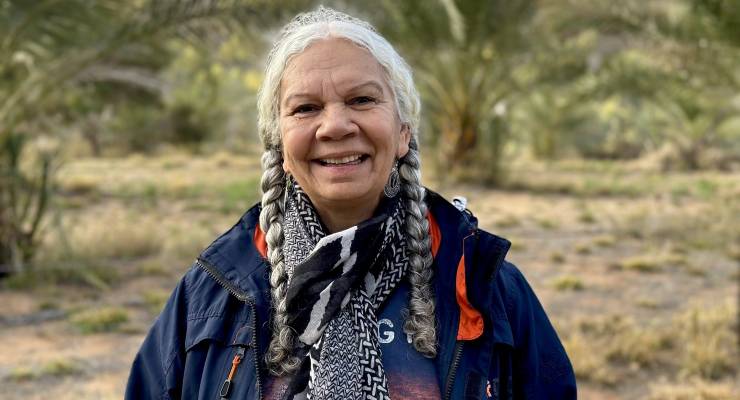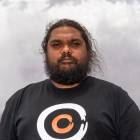
Aboriginal and Torres Strait Islander readers please note that this article mentions deceased persons.
First Nations educators are clear: they want their own system of education.
That’s the main message to come out of a landmark report released today by more than 50 First Nations educators at Utyerre Apanpe (oo-cherra a-parn-pa) — an annual Black-only education conference just east of Mparntwe (Alice Springs).
Named after the late Arrernte Elder Dr MK Turner OAM, the near-100-page policy document, “The MK Turner Report”, offers guiding principles, structures and recommendations on what makes a First Nations system of education and what is required to roll it out nationwide.
It’s called Apmerengentyele (Ap-mer-ung-n-jel-a), an Arrernte word meaning “from the land”. Here’s what it looks like in practice.
Understanding difference in a standard school day
A typical school day for a child in the Western education system might be a car drop-off, roll call, class one, recess, class two and three, lunch, class four, pick-up, home. Give or take a bit of sport and music, it’s heavy on numbers, big on literacy, and all done in English.
A First Nations model looks very different. Every day begins with first language. In one community, the school day might start with a bus pick-up for both children and parents (or carers). Kids are greeted in the language of their Country and they travel to school with family and community.
“They don’t have to travel 50kms into Mparntwe to go to a brick building that’s not welcoming. They get to go to a hub or a space that they know,” Gunggari woman Stacey Campton, director of First Nations education organisation Children’s Ground, tells Crikey and reporting partner Indigenous Community Television (ICTV), reiterating how important it is for a child to immediately understand that they are welcome.
A shared meal might come next, alongside a lesson on nutrition and health. Or it could be an hour of singing, dancing and another cultural ceremony, all done in first language and first language only.
Kids could help teachers pack the bus for a trip out on Country, where they‘re taught to hunt, dig and identify bush foods they can and can’t eat. It’s a morning of experiential learning and play.
Classroom-style teaching might feature later in the day, but First Nations education consultant Gamilaraay woman Aunty Joy Armstrong explains that this is all done through the First Nations lens of language, culture and Country. The most important thing, she says, is for Indigenous kids to know that they come from the land as this provides context for everything — connection to people, Elders, identity and Aboriginal lore.
“You take the time to open your eyes and see what’s around you. You would take the time to smell. You could then join in song with what’s around and it would be sung in language,” Armstrong says.
She points to movement and energy in children as something valuable, rather than an indicator that they’re problematic, unable to concentrate and ripe for medication.
“To really have a purposeful life, you need to have energy,” she says. “And to get that energy it is about putting your feet and stomping on the ground.”
The full sensory experience — sight, smell, sound, taste and touch — is critical for Indigenous peoples to understand the “spirit and soul” of language, Country, people and self.
“Why we haven’t reached our potential is because we’ve been trapped within these four walls and a roof. And a curriculum which only can work between four walls and a roof,” she says.
Founding chair of Children’s Ground and 2023 Male Elder of the Year Arrernte man William Tilmouth calls it assimilation. He says that learning without family, community, Country, language and identity is a recipe to lose yourself because you don’t know who you are and where you’re from.
As a member of the Stolen Generations, Tilmouth was taken away at the age of five to a Methodist mission on Croker Island, where he says he was sent to “assimilation school” and fed nothing but religion and education.
“Once I got ejected from the mission homes, the question I kept asking myself, ‘Who am I? Where do I come from? Where do I belong?’” he says.
“Coming back to Alice Springs, it was the old lady that we just had a bit of bad luck with [the late Dr MK Turner] who identified me. She said, ‘I know you, I know your skin, I know your family, I know your Country. And it made me feel, ‘Wow, I’m home, I’m coming home.’”
Metrics that tell kids they’re failures
After many years of teaching, Armstrong is now a First Nations education consultant. But in 2019 she decided to throw herself back into a classroom of 15- to 18-year-olds to test whether she still had it in her. She tells Crikey and ICTV that it took courage to stand up as a five-foot-tall (“Five foot in high heels,” she stresses) Gamilaraay woman in front of a room full of young and “much taller” men and women: “I was shaking in my boots.”
Armstrong says although the kids gave her a hard time as “the new person on the block”, the room was filled with joy and love, and she quickly found her groove. It’s these nurturing values of strength, confidence, compassion and energy that she says are at the core of a First Nations system of education.
“What do you need in a classroom? People have to love our children. Now you listen to educators — I don’t hear that word often within that space,” Armstrong says, reiterating that the message that rises above the rest is “all of our kids are failing”.
“That’s what we as a nation are told — our kids are behind, they’re behind the benchmarks, they’re behind this. I wouldn’t have any of that language.”
It’s a similar story for Gomeroi woman Alanah Jack, principal of the first bilingual school of an Aboriginal language in NSW — Gumbaynggirr Giingana Freedom School. She oversees a 100% Indigenous workforce and student cohort, where everything is taught first in Gumbaynggirr and second in English. Apart from still having to adhere to learning metrics such as NAPLAN, the curriculum is set by mob for mob.
Jack says her school stands apart from the academic-heavy curriculum that dominates Western education by privileging culture that is inherently humble, caring and nurturing, and which allows for support of the “whole child” — a baseline that readies them to engage in numeracy and literacy.
“Our kids, they know we love them, and we’re looking out for them,” she says. “And that in itself just makes a huge difference to the teaching and learning at our school.”
Inside the school gates, Jack points to students who came in restless, shy and afraid to ask questions and who are now thriving. But she says that change also travels home, with parents reporting they’re no longer battling to get kids out of bed to school: “They want to come to school; they want to be here; they want to be learning.”
It’s what Jack describes as a reciprocal cycle, with First Nations kids being healed by language, culture and Country and then taking on responsibility for the care and continuance of these things. She says everyone from kids to parents, families and communities are empowered by this increased appetite to learn and the confidence to teach.
Why a teacher doesn’t equal a piece of paper
In the Western system of education, no child, adult or Elder qualifies as a teacher unless they possess a certificate of accreditation. Tilmouth says that metric overlooks the 60,000-plus years of knowledge, expertise and lived experience that makes an Aboriginal teacher.
“Because you’re fluent in language, because you’re fluent in culture and identity and country, but you don’t have a certificate, you’re not considered to be worthy of being called a teacher,” he says.
“They do six years of university, but Aboriginal people, our old people, have done 70, 80 years of living under oppression and in extreme circumstances, and if they hadn’t learnt something, then you know, I’ll go.”










I am sympathetic to the First Nation plight. My own children attended a Rudolph Steiner school the philosophy of which can relate closely to many values listed here. However do the aims of the bilingual and First Nation culture based schools described here prepare children to partciipate in a western society or an indigenous one. This to me seems a dilemma.
I had a bilingual education in Holland (Friesian and Dutch languages) and we all picked up the dominant language (Dutch) totally fine. It’s the dominant language after all so it’s hard to miss.
It’s fine to include an element of indigenous culture however the purpose of education is to prepare students for the future. It’s not immediately clear what sort of future these students are being prepared for.
It should be noted that all of humanity rests on culture which goes back 10s of thousands of years. This is not something unique to indigenous people although the static nature of Australian indigenous culture is an interesting feature.
Nevertheless, the fact that they are getting the kids to attend has to be counted as a step in the right direction. The question is whether that is enough.
While so-called ‘Australian indigenous culture’ is 60,000 years’ old and the oldest surviving culture, it is not static.it’s apparent that some self-education about First Nations culture is required on the part of some respondents to this article.
Regrettably the curriculum as stated does not provide for a future away from their homeland.
But preferable to prison away from their homeland.
Many from remote areas are reluctant to move away from their homeland anyway. It’s a dilemma, specially with the latest drive to get more aboriginal kids to uni.
If the kids can thrive in the system described here they will be able to function in a western style economy. The main achievement of this system, as descibed, is to validate the ingenous students themselves. Once they have that they can make good progress in any system even though the pathways may be different to those of us whiteys.
Another Ace article. And there are people like Dutton who say we shouldn’t listen to them. What a fool he is.